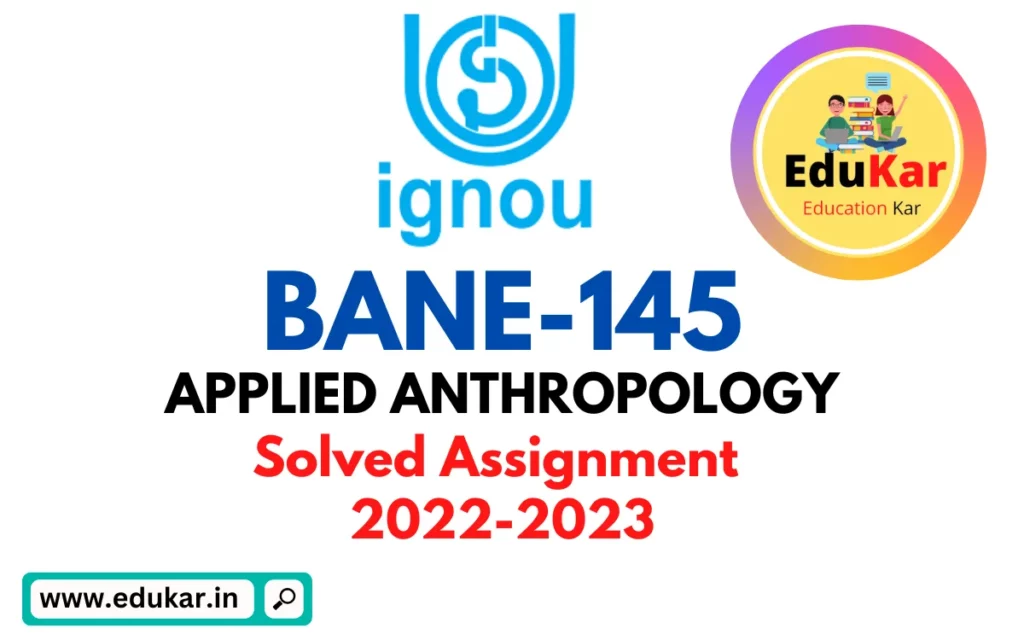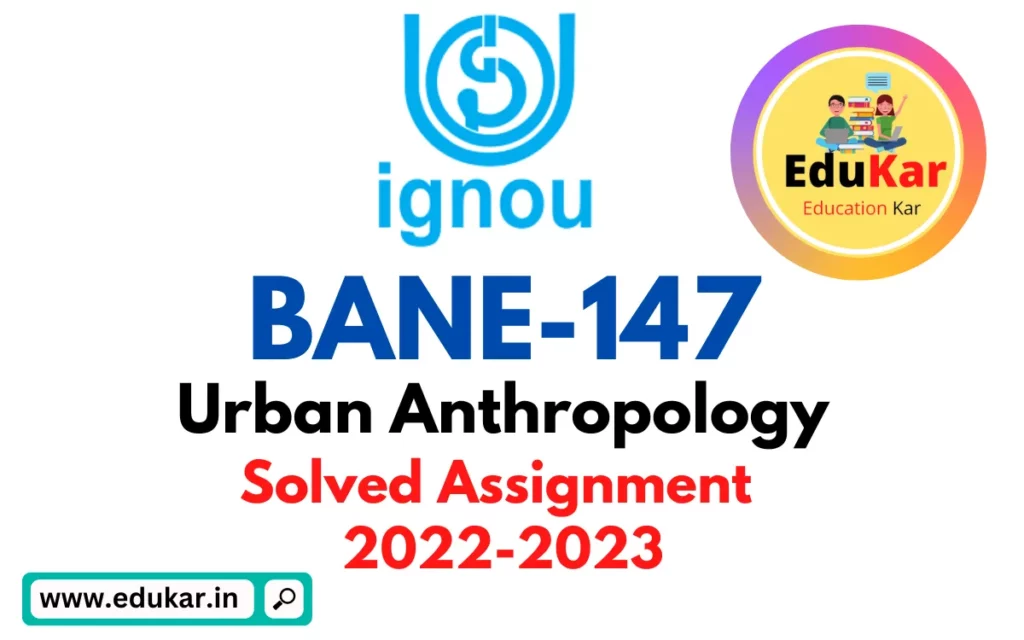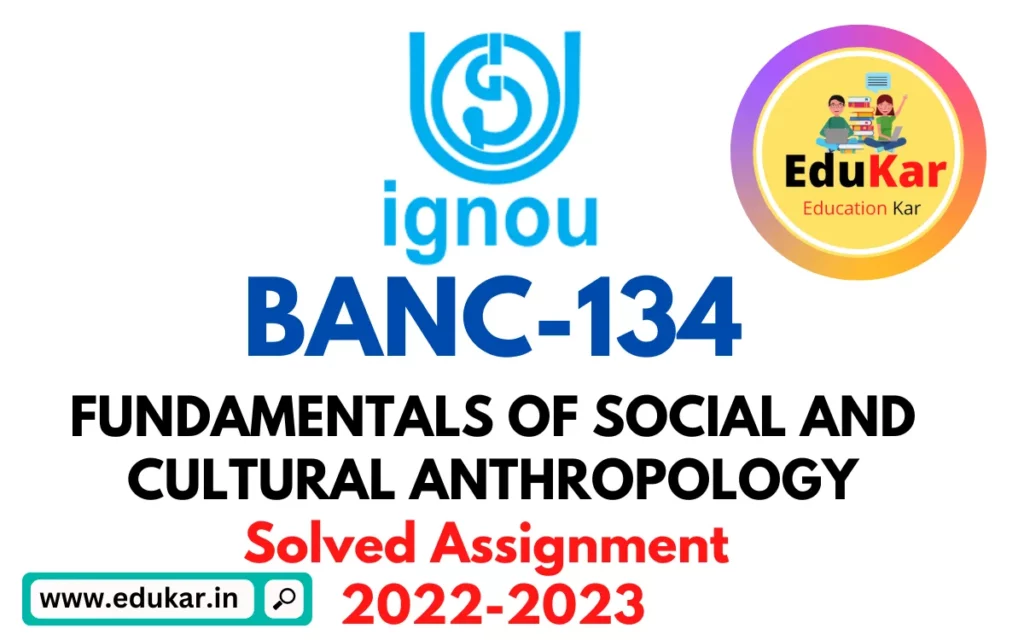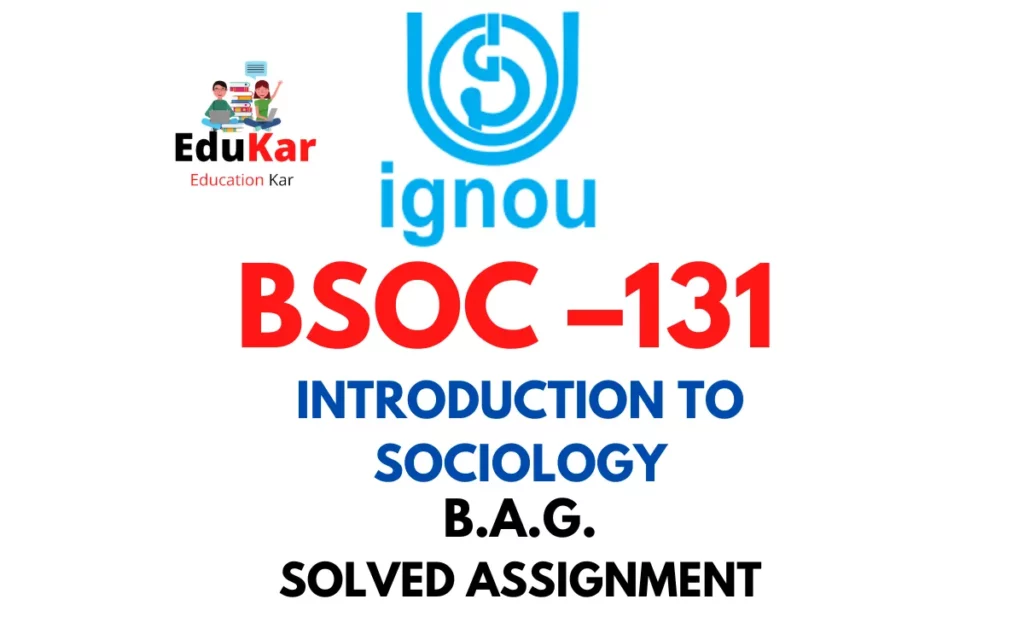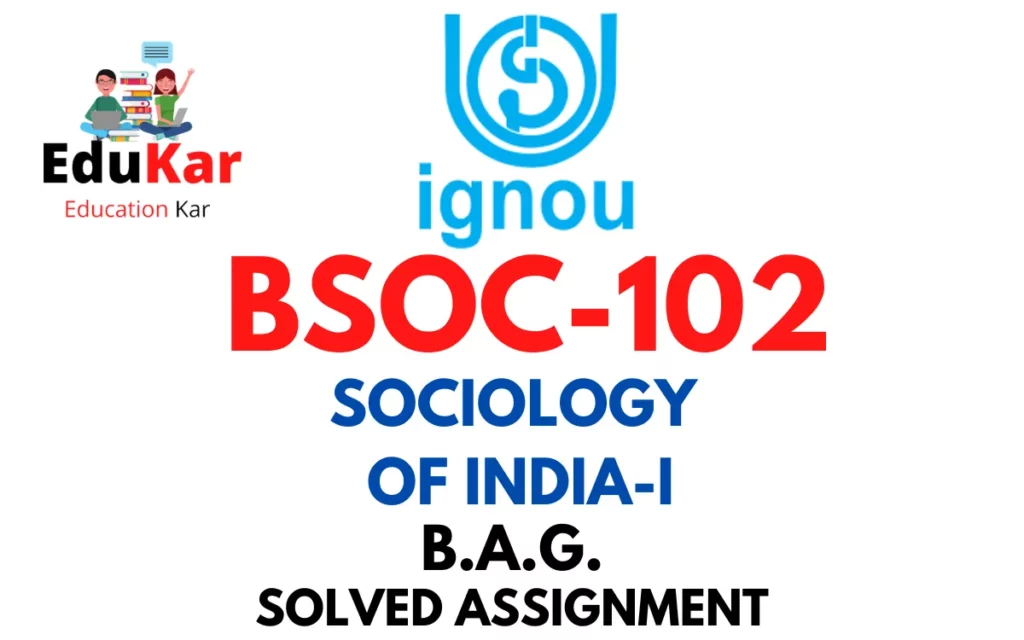Contents
- 1 Assignment – I
- 2 Answer the following in about 500 words each. 20X2= 40
- 3 a. Discuss the historical background of the development of Social and Cultural anthropology.
- 4 b. Describe fieldwork tradition in anthropology.
- 5 Assignment – II
- 6 Answer the following in about 250 words each. (Write Short Notes) 10X2=20
- 7 a. Discuss the Symbolic and Interpretive approach.
- 8 b. Write a note on kinship, family and marriage.
- 9 Answer the following questions in about 75 words each. 2X5=10
- 10 a. Religious institutions
- 11 b. Evolutionism
- 12 c. Structural- functionalism
- 13 d. Rapport Building
- 14 e. Tribes and Bands
- 15 Assignment – III
- 16 a. Select either Slums in India or Ethnography of a Village as a topic. Write the steps forpreparing a synopsis emphasizing on the significance of your study, unit of study,methods, tools and techniques.
- 17 b. Write a short essay in 500 words on your experience of spending time with yourfamily during the lockdown owing to the pandemic COVID 19. 5
- 18 c. Correct the reference style and arrange them alphabetically.
- 19 i. Illinois: Waveland Press. 1972. Kaplan, David and Robert A Manners. CultureTheory.
- 20 ii. Oxford: The Clarendon Press Evans-Pritchard, E. E. 1940. The Nuer.
- 21 iii. Fortes. Meyer, 1969. Kinship and the Social Order. Aldine Publishers. Chicago
- 22 iv. 1985. Good to Eat: Riddles of Food and Culture. Waveland Press: Illinois. Harris, Marvin.
- 23 v. Cultural anthropology (7 th ed.)Mead, M. 1964 . Anthropology: A human science. New York: D. Van Nostrand Co., Inc. Miller, B.D. 2012 . Pearson.

| Title | BANC-102 |
| University | IGNOU |
| Degree | Bachelor Degree Programme |
| Course Code | BANC-102 |
| Course Name | INTRODUCTION TO SOCIAL AND CULTURAL ANTHROPOLOGY |
| Programme Name | Bachelor of Arts (General) |
| Programme Code | BAG |
| Total Marks | 100 |
| Year | 2022-2023 |
| Language | English |
| Assignment Code | BANC 102/ASST/TMA/JULY 2022 AND JANUARY 2023 |
| Last Date for Submission of Assignment: | For June Examination: 31st April For December Examination: 30th September |

Assignment – I
Answer the following in about 500 words each. 20X2= 40
a. Discuss the historical background of the development of Social and Cultural anthropology.
Ans: The historical background of the development of Social and Cultural Anthropology can be traced back to the late 19th and early 20th centuries. During this time, anthropologists began to shift their focus from the study of anatomy and physical differences between human populations to the study of cultural differences.
One of the earliest figures in this field was the British anthropologist, E.B. Tylor. Tylor is best known for his work in establishing the concept of “cultural evolution,” which posits that cultures change and evolve over time in a process similar to biological evolution. Tylor also developed the concept of “cultural relativism,” which argues that cultural practices should be understood and evaluated in the context of the culture in which they exist, rather than being judged by the standards of another culture.
Another important figure in the development of social and cultural anthropology was Franz Boas. Boas was a German-American anthropologist who is often referred to as the “father of American anthropology.” He challenged the concept of cultural evolution and argued that cultural practices could not be understood as the result of a single process of development. Instead, he argued that each culture must be understood as the result of a unique historical process, shaped by a range of factors including environment, geography, and historical events.
In the first half of the 20th century, social and cultural anthropology continued to grow and develop. Anthropologists began to focus more on the study of “primitive” societies, such as those found in Africa, the Pacific, and Latin America. This was a time of great exploration and discovery, as anthropologists traveled to far-flung corners of the world to study new and exotic cultures.
After World War II, the focus of social and cultural anthropology shifted once again. Anthropologists began to study not only traditional societies but also modern societies, such as those found in the United States and Europe. This new focus brought with it new questions and concerns, such as the impact of globalization, the role of technology in shaping culture, and the changing nature of family and community in the modern world.
Throughout its history, social and cultural anthropology has been a dynamic and evolving field, shaped by the changing perspectives of its practitioners and the ever-changing world around them. Today, social and cultural anthropology continues to play an important role in our understanding of the human experience, providing insight into the diversity of cultures, beliefs, and practices that exist around the world.
b. Describe fieldwork tradition in anthropology.
Ans: Fieldwork is a central tradition in anthropology and refers to the practice of conducting ethnographic research in a community or society, typically by living among the people being studied and participating in their daily lives. Fieldwork provides an opportunity for anthropologists to gather detailed and in-depth information about a culture or society, and to develop a nuanced understanding of the beliefs, practices, and experiences of the people they are studying.
The fieldwork tradition in anthropology has its roots in the early 20th century, when anthropologists such as Franz Boas, Bronislaw Malinowski, and Marcel Mauss began to conduct extensive fieldwork among indigenous communities in Africa, Oceania, and other parts of the world. These early anthropologists revolutionized the discipline by emphasizing the importance of “being there” and experiencing the culture firsthand, rather than relying solely on written accounts or second-hand observations.
One of the key features of fieldwork is the development of close relationships with the people being studied. Anthropologists often spend months or even years living among the people they are studying, participating in their daily activities and building relationships of trust and mutual understanding. This process allows anthropologists to gain a deep understanding of the cultural practices and beliefs of the people they are studying, and to develop a unique perspective on their experiences and perspectives.
Another important aspect of fieldwork is the use of participant observation, which involves the anthropologist actively participating in the cultural practices of the community they are studying. This may include attending religious ceremonies, participating in community events, or even participating in the day-to-day activities of the community, such as farming, fishing, or cooking. Through this process, the anthropologist is able to gain a rich understanding of the culture and to develop a unique perspective on its beliefs and practices.
Fieldwork also involves the collection of a wide range of data, including observations, interviews, and material culture, such as artifacts and photographs. Anthropologists use these data to develop a comprehensive understanding of the culture they are studying and to provide a nuanced and multi-dimensional view of the beliefs, practices, and experiences of the people they are studying.
Assignment – II
Answer the following in about 250 words each. (Write Short Notes) 10X2=20
a. Discuss the Symbolic and Interpretive approach.
Ans: The Symbolic and Interpretive approach is a perspective in anthropology that emphasizes the importance of understanding the symbolic and cultural meanings behind human behavior and social practices. This approach asserts that human behavior is not simply a product of individual choice, but is shaped by the symbolic and cultural systems in which people are embedded.
Central to this perspective is the idea that culture is not just a set of beliefs and practices, but is a symbolic system that provides meaning and understanding to human experience. Symbols, such as language, rituals, and objects, play a critical role in shaping human behavior and social practices, and are used to convey cultural values and beliefs.
Advocates of the Symbolic and Interpretive approach reject the idea that human behavior can be understood in terms of objective, universal laws or rules, and instead focus on the ways in which people make sense of the world through the use of symbols and cultural meanings. They argue that human behavior cannot be reduced to simple cause-and-effect relationships, and that understanding the symbolic and cultural dimensions of human experience is critical for a full understanding of human behavior.
One of the key features of the Symbolic and Interpretive approach is the focus on the subjective and interpretive nature of human experience. This perspective argues that people do not simply respond to objective reality, but actively create meaning through their perceptions and interpretations of the world around them.
In practice, the Symbolic and Interpretive approach involves the use of qualitative methods, such as in-depth interviews and participant observation, to gather data about the cultural meanings and symbolic systems that shape human behavior. It also often involves the use of close textual analysis, such as the analysis of ritual practices, religious texts, and other cultural artifacts, to uncover the symbolic meanings behind human behavior.
b. Write a note on kinship, family and marriage.
Ans: Kinship, family, and marriage are central concepts in anthropology that help to explain the relationships and social structures that exist within human societies.
Kinship refers to the social relationships that exist between individuals in a society, and is often used to describe the relationships between family members, such as parents, siblings, and grandparents. Kinship relationships are based on biological, cultural, or legal ties, and can vary greatly across different cultures and societies.
Family refers to a group of individuals who are related by blood, marriage, or adoption, and who share a common household and pool their resources. Family is a crucial social institution that provides emotional, economic, and social support to its members, and plays an important role in the transmission of culture and values from one generation to the next.
Marriage is a social and cultural institution that involves the union of two individuals in a legally or culturally recognized relationship. Marriage is used to establish social and economic ties between two families and to provide a stable and supportive environment for the raising of children. Marriage practices vary greatly across cultures and can include arranged marriages, monogamous marriages, and polyggynous marriages.
Answer the following questions in about 75 words each. 2X5=10
a. Religious institutions
Ans: Religious institutions are social organizations that are dedicated to the practice and promotion of a particular religion. They may include churches, synagogues, temples, mosques, and other religious organizations, and serve as a center for religious worship, education, and community building. Religious institutions play a significant role in shaping individual beliefs and behaviors, and can influence larger social, political, and economic systems. They often provide a sense of community and social support for their members, and serve as a source of cultural and moral guidance.
b. Evolutionism
Ans: Evolutionism is a theoretical perspective in anthropology that seeks to explain cultural and social change as the result of a natural, progressive evolution from simple to more complex forms. It was popular in the late 19th and early 20th centuries and influenced by the ideas of Charles Darwin and Herbert Spencer. Evolutionists argued that cultural and social evolution followed similar patterns to biological evolution, with societies and cultures evolving from simple to complex forms through stages of development. This perspective was heavily criticized for its cultural and racial biases, as well as for its oversimplification of cultural and social change, and has largely been discredited in contemporary anthropology.
c. Structural- functionalism
Ans: Structural-functionalism is a sociological perspective that views society as a complex system made up of interdependent parts that work together to maintain stability and order. This perspective argues that social institutions, such as families, schools, and religious organizations, serve specific functions that contribute to the overall stability of society. It also emphasizes the role of social norms and values in maintaining social order. Structural-functionalism suggests that changes in one part of society will impact other parts and lead to a readjustment of the entire system. This perspective was popular in the mid-20th century, but has since been criticized for its lack of attention to power dynamics and social inequality.
d. Rapport Building
Ans: Rapport building is the process of establishing a positive and empathetic relationship with others. It involves creating trust and mutual understanding by showing interest in others, actively listening, and demonstrating empathy. Effective rapport building can help to establish a climate of cooperation and collaboration, which can be particularly important in situations such as negotiations, sales, customer service, and therapy. The skills of rapport building can be improved through practice, self-awareness, and a genuine interest in connecting with others. When successful, rapport building can lead to improved communication, reduced conflicts, and greater satisfaction in relationships.
e. Tribes and Bands
Ans: Tribes and bands are two forms of pre-state societies, typically characterized by small, egalitarian communities that are organized around extended kin networks.
A tribe is a larger form of pre-state society, typically composed of several bands and often based on shared cultural and linguistic characteristics. In a tribe, political authority is typically distributed and decision-making is achieved through consensus.
A band, on the other hand, is a smaller and more loosely organized form of pre-state society, composed of close relatives and friends. Bands are often based on familial ties and face-to-face relationships, with decisions made through informal consensus-based processes.
Both tribes and bands rely on subsistence economies, such as hunting and gathering or small-scale agriculture, and they typically lack a centralized political authority. These forms of pre-state societies are found in many parts of the world and serve as a basis for understanding the development of larger, more complex societies.
Assignment – III
a. Select either Slums in India or Ethnography of a Village as a topic. Write the steps for
preparing a synopsis emphasizing on the significance of your study, unit of study,
methods, tools and techniques.
Ans: Tribes and bands are two forms of pre-state societies, typically characterized by small, egalitarian communities that are organized around extended kin networks.
A tribe is a larger form of pre-state society, typically composed of several bands and often based on shared cultural and linguistic characteristics. In a tribe, political authority is typically distributed and decision-making is achieved through consensus.
A band, on the other hand, is a smaller and more loosely organized form of pre-state society, composed of close relatives and friends. Bands are often based on familial ties and face-to-face relationships, with decisions made through informal consensus-based processes.
Both tribes and bands rely on subsistence economies, such as hunting and gathering or small-scale agriculture, and they typically lack a centralized political authority. These forms of pre-state societies are found in many parts of the world and serve as a basis for understanding the development of larger, more complex societies.
b. Write a short essay in 500 words on your experience of spending time with your
family during the lockdown owing to the pandemic COVID 19. 5
Ans: The COVID-19 pandemic has brought many changes to our lives, including the way we spend our time. One of the most significant changes for me was spending extended periods of time with my family during the lockdowns. While being confined to our home was challenging at times, it also provided an opportunity for us to slow down and connect with each other in a way that would not have been possible otherwise.
During the lockdowns, my family and I had to cancel all our plans and activities, including trips, outings, and visits to friends and relatives. Initially, this was difficult for us as we were used to being on the go and having a busy schedule. However, we soon realized that this was an opportunity to spend quality time together as a family. We bonded over meals, games, and movies and also took up new hobbies like cooking, gardening, and reading.
One of the highlights of the lockdown was being able to sit down together for meals. We would take turns cooking and sit down together as a family to enjoy our meals. This was a significant change from our usual routine, where we would often eat on the go or in front of screens. The meals were not only a time for us to refuel, but also to catch up on each other’s lives and have conversations that we may not have had otherwise.
Another activity that brought us closer was playing games together. We played board games, card games, and even video games. This was a fun way to pass the time and also to bond with each other. We also took up new hobbies like gardening and cooking, which were not only productive but also helped us to spend time together while learning new skills.
Reading was another activity that we all took up during the lockdown. We would often spend hours lost in a good book, and it was a great way to escape the stress and worries of the world. We also had book club meetings where we would discuss the books we were reading and share our thoughts and opinions.
c. Correct the reference style and arrange them alphabetically.
i. Illinois: Waveland Press. 1972. Kaplan, David and Robert A Manners. Culture
Theory.
Ans: Kaplan, David, and Robert A Manners. 1972. Culture Theory. Illinois: Waveland Press.
ii. Oxford: The Clarendon Press Evans-Pritchard, E. E. 1940. The Nuer.
Ans: Evans-Pritchard, E. E. 1940. The Nuer. Oxford: The Clarendon Press.
iii. Fortes. Meyer, 1969. Kinship and the Social Order. Aldine Publishers. Chicago
Ans: Fortes, Meyer. 1969. Kinship and the Social Order. Chicago: Aldine Publishers.
iv. 1985. Good to Eat: Riddles of Food and Culture. Waveland Press: Illinois. Harris, Marvin.
Ans. Harris, Marvin. 1985. Good to Eat: Riddles of Food and Culture. Illinois: Waveland Press.
v. Cultural anthropology (7 th ed.)Mead, M. 1964 . Anthropology: A human science. New York: D. Van Nostrand Co., Inc. Miller, B.D. 2012 . Pearson.
Ans: Mead, M. 1964. Cultural Anthropology (7th ed.). New York: D. Van Nostrand Co., Inc. Miller, B.D. 2012. Anthropology: A Human Science. Pearson.
How to Download BANC-102 Solved Assignment?
You can download it from the www.edukar.in, they have a big database for all the IGNOU solved assignments.
Is the BANC-102 Solved Assignment Free?
Yes this is absolutely free to download the solved assignment from www.edukar.in
What is the last submission date for BANC-102 Solved Assignment?
For June Examination: 31st April, For December Examination: 30th October

